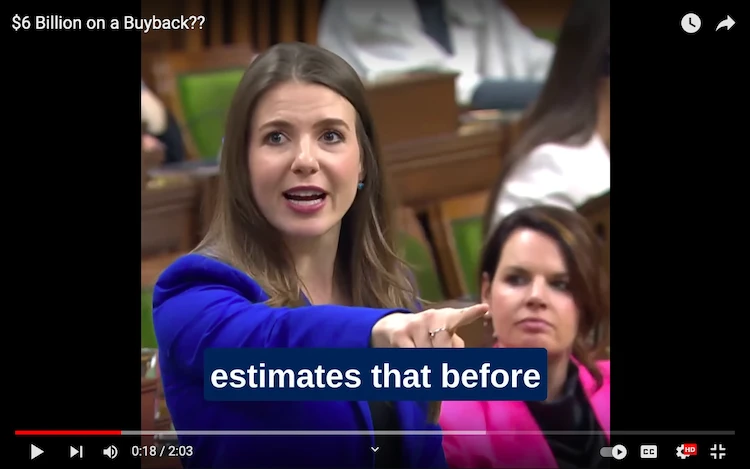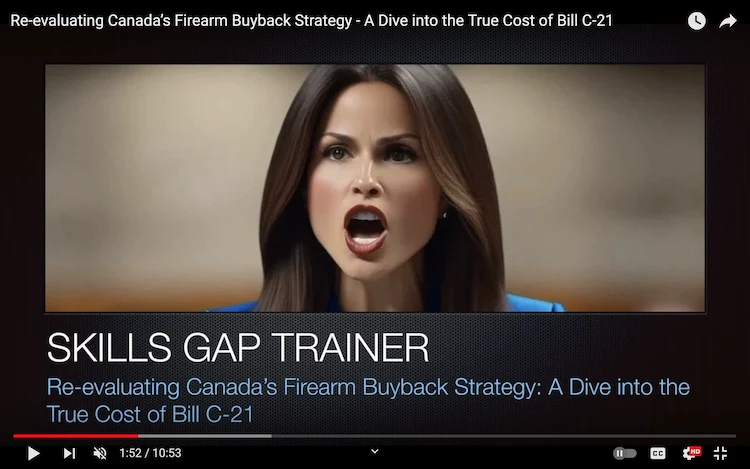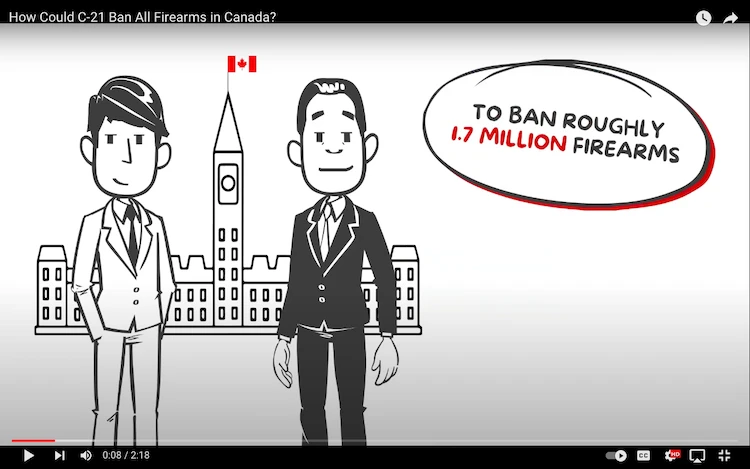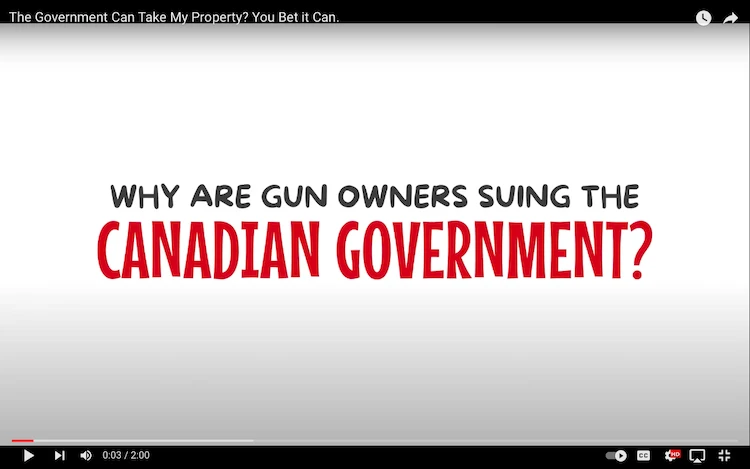Video Title: $6 Billion on a Buyback??
Video Title: Re-evaluating Canada’s Firearm Buyback Strategy – A Dive into the True Cost of Bill C-21
Welcome Canadians, to an exciting speech, that is best accompanied by Canadian produced Nostalgic Synthwave Retro 80s. In the face of 21st-century crises, challenges & mega-threats, understanding the true implications of decisions, especially those concerning public safety & finance, becomes paramount. While the advertised price tag of Bill C-21’s buyback program might seem straightforward, at measly little $1400 per firearm, a more involved analysis paints a vastly different picture, one that dives into the intricate realms of economics, asset valuation, opportunity costs & societal implications.
Opportunity Cost & Economic Growth: The Canadian government’s focus on this firearm confiscation initiative, Bill C-21, from 2000 to 2023 represents a significant missed opportunity. The time, attention, & resources, which translate to three years of government operation not focused on key economic export sectors, & with proper legislative attention and focus, could have driven & assisted growth to Canadian export industries in excess of $100 billion of increased economic activity per sector. Instead of focusing on property confiscation from citizens, particularly people who are working class & interested in doing shooting sports (IPSC) & working to bolster the economy, the only type of property that millenials, Gen Z or immigrants can afford, firearms, efforts could have been channeled into sectors like western resources, energy, farming, exports, mining, technological growth, manufacturing EV cars, EV busies, EV high speed rail via Bombardier, buying the truckers new Tesla EV trucks as an apology, emergency planning, resilience enhancement, hospital backups, pharmacy & medical expert backups, military preparedness, citizen resiliency, food & water systems backups, & even bolstering our medical workforce, especially in light of the impending retirement of nearly 47% of family practitioners who say they wish to close shop within the next 5 years. The most unprofessional person in Canada, or the worst worker team candidates in Canada, would not make this severe mis-allocation of national resources.
Asset Mis-pricing – Understanding Firearms Beyond Manufacturing Costs: Director Valentin from SGT offers a compelling viewpoint, rooted in historical, practical and professional experience. Firearms from Beretta, Benelli, Sako, Tikka, Cadex, B&T, Black Creek Labs, are like Swiss or Japanese mechanical watches or timeless, evolved, sophisticated mechanical art pieces of great historical relevance, heritage & value. Firearms shouldn’t be evaluated just on their production cost and are completely mis-priced as to their role in human history & human impact. These are worth more than any car on Vancouver Island, which are poorly engineered 10 000 lbs iron paper weights, obsolete electro-mechanical devices, gas cars which have not advanced in engineering quality since 1885, with the exception of a bit of a few recent EV’s that will be quickly become obsolete, and have not improved the aesthetic, environmental quality or functional design quality of the cities of the world, and which will not be on the road in 5 or 10 years time, let alone 100 to 300 years like a Tikka TAC A1 or Beretta X400 Shotgun will be. None of these vehicles stick to the quality engineering principles of the firearms, are perishable, and have no value as an asset. The asset people have is their firearm. Their cash accounts or stocks have 40 risks implicit in their operating agreement with their bank, including being un-hedged across the board for all Canadian portfolios, putting every Canadian in a great deal of danger with their local banking establishment of the type of continual purchasing power loss we are seeing, with devastating account loss risks such as currency risk, & are not assets. Firearms represent an alternative currency, an asset class that, depending on economic conditions, such as increasing interest rates, increasing inflation, WAR, mass migration, commodity re-valuation, manufacturing scarcity, can see its value skyrocket. In hyperinflation scenarios, for instance, a firearm’s worth could surge to a staggering million dollars. Yet, the current pricing model of $1400 drastically undervalues them, on a historical basis, on a current valuation basis, and on a forward projection basis based on data known from the great Amazing megacrises of the 21st century expectation among intellectual authors who are successful on Amazon. The $1400 dollar confiscation offer pretends the value is closer to production costs rather than their value as an alternative asset & a critical asset of the 21st century.
Direct Financial Implications of the Buyback: The government might estimate the repurchase of a firearm at $1,400. However, when we account for initial purchase prices, which can lie between $5,000 to $7,000, the $1400 that the government buys it back with, & the consequent asset destruction of the $7000 dollar rifle, the cost is then $15,400 per firearm, excluding all of the other costs mentioned in this analysis. Redirecting these funds towards healthcare, for instance, could potentially aid many, such as the elderly who struggle with medical expenses.
Business Opportunity Cost: Beyond individual owners, businesses connected to the firearms industry face a ripple effect of uncertainty & losses. This cost won’t likely be factored into government calculations but remains very real for local economies and workers. Ranges, distributors, retail shops, gunsmiths, reloading facilities, training facilites, sports clubs, hunting & outfitters, designers, manufacturers, & responsible firearm owners.
Security Implications & Public Safety: As civilian firearms expertise diminishes, Canada’s military & public service agencies will face increased pressure to bolster its strength, leading to heightened costs. This comes at a time when the military is being reduced in strength on a gradual and multi-decade basis, including the police and the border security as well, with decreasing officer counts contrasted against increasing immigration counts. Moreover, public safety agencies would need to invest more in training and facilities, to compensate for the contributions that responsible firearms owners make to maintaining the security infrastructure and ecosystem in Canada in place, through contributing at least 28 000 per new firearms owner to the business environment and outfitters of Canada via purchases alone, adding to the financial & logistical burden of the working class & the elderly to replace these ‘domestic and foreign security infrastructure support costs’ that responsible firearm owners inadvertently fund via their interest in things such as hunting & sports shooting or simple practice and recreation and outdoor adventure & expedition.
Administrative Overheads & Logistical Challenges: The buyback involves extensive negotiations with millions of firearm owners, collection, & subsequent procedures, with volunteers and administrative officials bearing significant responsibilities. This enormous logistical undertaking brings along a hefty price tag.
Border Security, RCMP, Engineers, Technologists & Computer Scientists of Canada: With reduced resources, as evident by the dwindling numbers of border officers from 8500 to 6500 recently, as published on government of Canada websites which are not updated on a regular basis, our ability to combat illicit firearms and ensure border security wanes. This increases the drug smuggling & crime creation problem. The RCMP, police, and border forces need adequate funding to effectively combat threats, to effectively deploy scanning devices, engineers, computer scientists, drones, robotic surveillance electric ATV’s to scan the border, yet their capital allocation seems compromised by the buyback program. As a result, the engineering ecosystem, the border security eco-system, & the RCMP are compromised & disabled by the federal government from pursuing and achieving security & technological progress in the 21st century for Canadians.
Addressing the Root – Crime & Illegal Firearm Influx: With funds potentially being redirected from border security & law enforcement agencies, the ability to halt illegal firearm influx becomes challenging. In turn, this can lead to increased crime rates, setting off a chain reaction of societal & economic implications.
The Essence of Thoughtful Policy-making: Granular thinking is the hallmark of a progressive and effective policy framework legislation writer and is the hallmark of a fantastic engineer. When we examine Bill C-21 through this lens, several questions emerge. Could funds allocated for this initiative be better used elsewhere? Might they bring more substantial benefits if invested in youth programs, drone technology manufacture for enhanced border protection, technological enhancements at ports via advanced scanning devices, or other early intervention strategies?
Canada stands at a pivotal juncture. We are at the pivotal moment of a transition into the 21st century, a multi-polar world order, and everyone is trying to write a dark and awful story. The nation needs policies steeped in rigorous economic analysis, understanding of diverse implications, and a genuine commitment to public safety. Engineers, better pay attention more when public safety is breached and write technical reports that push refined legislative design and leadership into society when people try to threaten public safety. Bill C-21 needs to be replaced with a bill that achieves public safety within the context of greater engineering, security ecosystem, alternative asset understanding, economic realism and geopolitical understanding. – SGT Team
@ergocentric comment:
Skills Gap Trainer comment:
@nedrawmit comment:
Skills Gap Trainer comment:
Not intending to monopolize the entirety of this thread with comments, but Raquel, you’ve undoubtedly crushed the opponents as usual, burying them deeper than any graveyard available in Canada. Even if our adversaries achieved a victory or two in court, away from our scrutiny, that’s the only realm they’ll triumph in as long as you stand for us in public forums. In the court of public opinion, among rational and responsible minds, you are the undefeated champion. That’s precisely why watching your videos can be difficult; witnessing your continual victories, the inevitable crushing of the opposition, brings predictability and an unwarranted sense of mercy for those undeserving in debate, simply because we know as a matter of fact that any response to your statements will be inadequate and insufficient to address the logic you bring up. History will remember who stood for reason, who stood for logic, who attempted to use Canada’s resources efficiently, who was committed to a balanced, secure society, and who advocated for principled and well thought out leadership decisions. For those of you that like fighting sports, forget boxing or martial arts; they teach of physical combat and fitness, along one domain of fighting, not the art of overcoming life’s multifaceted challenges of the 21st century, or the diverse preparatory, debate and fighting and STEM engineering and science capabilities one will need going forward. If one wishes to see a more profound defeat than that a bloody MMA match, they should watch Dancho at work. From Raquel Dancho and Skills Gap Trainer, you will learn everything you need to know to set things right with the future.
Related books and resources:
“More Guns, Less Crime: Understanding Crime and Gun Control Laws” by John R. Lott Jr. – Offers statistical analysis relevant to discussions on firearm legislation and public safety, supporting the article’s focus on data-driven approaches.
“The Bias Against Guns: Why Almost Everything You’ve Heard About Gun Control Is Wrong” by John R. Lott Jr. – This book questions common perceptions about gun control, pertinent to the article’s critique of Bill C-21’s buyback strategy.
“The Economics of Public Issues” by Roger LeRoy Miller, Daniel K. Benjamin, and Douglass C. North – Provides insights into how economic principles apply to public policy decisions, relevant to the discussion of opportunity costs and economic growth.
“Guns, Crime, and Freedom” by Wayne LaPierre – Offers a perspective from the National Rifle Association on firearm legislation’s impact on freedom and safety, aligning with discussions on civil liberties and security.
“Canadian Public Budgeting in the Age of Crises: Shifting Budgetary Domains and Temporal Budgeting” by G. Bruce Doern and Allan M. Maslove – Relevant for understanding the fiscal context within which Bill C-21’s buyback program is being debated.
“Firearms and Violence: A Critical Review” by the National Research Council of the National Academies – Provides an academic perspective on the relationship between firearms and violence, contributing to a nuanced discussion on firearm policies.
“The Gun Debate: What Everyone Needs to Know” by Philip J. Cook and Kristin A. Goss – Presents balanced information on gun control debates, useful for readers seeking a comprehensive overview of the issues surrounding firearms policies like Bill C-21.
“Economics for Investment Decision Makers: Micro, Macro, and International Economics” by Christopher D. Piros and Jerald E. Pinto – While not directly related to firearms, this book provides economic principles that can be applied to understanding the broader implications of government spending and policy decisions.
“Public Finance and Public Policy” by Jonathan Gruber – Addresses the implications of government interventions and spending, pertinent to the discussions on the financial aspects of the firearm buyback program.
“Asset Pricing and Portfolio Choice Theory” by Kerry E. Back – Offers insights into asset valuation, relevant to our article’s discussion on the mispricing of firearms under Bill C-21’s strategy.
To see our YouTube Channel, click https://www.youtube.com/@skillsgaptrainer
“Discover the future of learning with Skills Gap Trainer, where technology meets art, and education transcends boundaries. Our innovative curriculum in AI, blockchain, user experience, digital marketing, and more, isn’t just about acquiring skills — it’s about mastering the art of possibility in a digitalized world. By linking to us, you’re not just sharing a resource; you’re igniting a beacon of knowledge that enlightens paths in technology, leadership, and beyond, for a global community of learners. Join us in our mission to bridge the skills gap and shape the future of education. Together, let’s empower minds across Canada, America, Europe, Britain, India, and beyond. Link to Skills Gap Trainer – where learning meets innovation, and every click opens a door to endless possibilities.“






